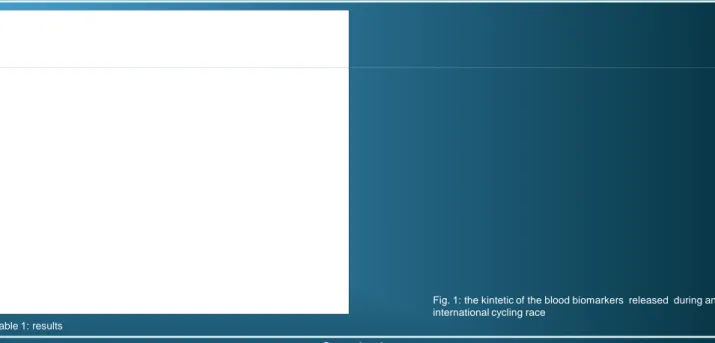TWO BIOMARKERS FOR THE SCREENING
OF CARDIAC RISK AMONG RUNNERS?
Background:
Heart-type fatty acid-binding protein (H-FABP) is a low molecular weight protein involved in the intracellular uptake and buffering of long chain fatty in the myocardium. Troponin T is a component of the contractile apparatus of the striated musculature. Both are early markers for acute coronary syndrome.
Le Goff C.1, Kaux J.-F. 3, Fillet M. 4, Melon P. 2, Cavalier E1.
1Department of Clinical Chemistry, University Hospital of Liege, Belgium 2Department of Cardiology, University Hospital of Liege, Belgium
3Department of Motility Sciences, University of Liege, Belgium
4Department of Analytical Pharmaceutical Chemistry, University of Liege, Belgium
Objective:
The aim of our study was to compare the results obtained with the H-FABP and the highly sensitive cardiac troponins (hsTnT) and to test their cardiospecificity in healthy runners
Design: Prospective, cohort study. Setting; Amateur marathon runner.
Methods:
Twenty three runners (marathon) (44,1 ± 8,37 years old
)
were enrolled.We drowned blood samples at three times: just before (T0), just after (T1), and three hours after the end of the race (T3).
Main outcome measurements: H-FABP and hs-TnT were performed according to the manufacturer's instructions. A linear regression was calculated to observe if there is any correlation between the two
biomarkers. Values above the 95th percentile for H-FABP (2.5 ng/mL) and the 99th percentile for hsTnT (14 ng/L) were considered as positive.
Results:
At T0, none of the subjects were positive for hsTnT but 35% were positive for H-FABP;
at T1, 83% for hsTnT and 100% for H-FABP; at T3, 83% for hsTnT and 96% for H-FABP (table 1).
At T0, the regression equation was H-FABP T0 = 3.9454 – 0.1001 x hsTnT T0; at T1: H-FABP T1 = 51.838 – 1.7026 x hsTnT T1; at T3: H-FABP T3 = 47.977 – 1.6193 x hsTnT T3 (figure 1). No correlation was observed between the two biomarkers at the different time.
Conclusions:
We observed a significant increase of H-FABP and hsTnT in runners. These markers are independent to each other. These values could biologically correspond to a heart ischemia. These biomarkers could be helpful for the screening of cardiac risk among runners.
Acknowledgement: This experimentation was partially financed by “Adeps 2012” grants (Léon Frédéricq Funds).
Fig. 1: the kintetic of the blood biomarkers released during an international cycling race
